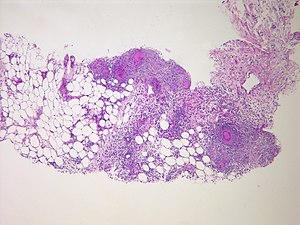Peritonitis
Peritonitis is inflammation of the peritoneum, the lining of the inner wall of the abdomen and cover of the abdominal organs[1]. If left untreated, it can be life threatening.
| Peritonitis | |
|---|---|
| Other names | Surgical abdomen, acute abdomen[2] |
 | |
| Peritonitis from tuberculosis | |
| Pronunciation | |
| Medical specialty | Emergency medicine, general surgery |
| Symptoms | Severe pain, swelling of the abdomen, fever[1][3] |
| Complications | Sepsis (sepsis is likely if not quickly treated), shock, acute respiratory distress syndrome[4][5] |
| Usual onset | Sudden[2] |
| Types | Primary, secondary, tertiary, generalized, localized[2] |
| Causes | Perforation of the intestinal tract, pancreatitis, pelvic inflammatory disease, cirrhosis, ruptured appendix[3] |
| Risk factors | Ascites, peritoneal dialysis[4] |
| Diagnostic method | Examination, blood tests, medical imaging[6] |
| Treatment | Antibiotics, intravenous fluids, pain medication, surgery[3][4] |
| Frequency | Relatively common[2] |
Symptoms
Signs and symptoms may include:
- severe pain in the stomach[3]
- fever, or feeling hot and shivering[3]
- tachycardia (quick heart rate)[3]
- trouble urinating or urinating less than usual[3]
- weight loss.[5]
There may also be swelling in the abdomen, feeling or being sick, and a loss of appetite.[3]
If peritonitis happens while kidney dialysis treatment is being used, the fluid in the collection bag might look cloudier than usual or contain white flecks.[3]
Causes
Include[3]:
- perforation of the intestinal tract
- pancreatitis
- pelvic inflammatory disease
- burst stomach ulcer
- cirrhosis
- ruptured appendix.
- digestive problems (example Chron's disease or diverticulitis)
- surgery
The lining of the stomach (peritoneum) covers internal organs like the kidneys, liver and bowel. If the lining becomes infected and you get peritonitis, the internal organs it covers can also be damaged.
Treatment
After a peritonitis diagnosis, treatment in hospital is needed to get rid of the infection.Treatment usually involves being given antibiotics into a vein (intravenously).[3]
If regular kidney dialysis is ongoing, a doctor might discuss a different way of doing it until the peritonitis has been treated.[3]
Related pages
- appendix
- gallbladder
- acid reflux
